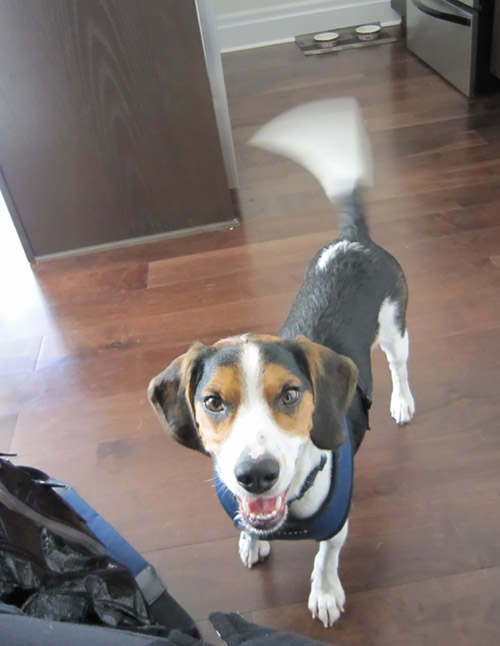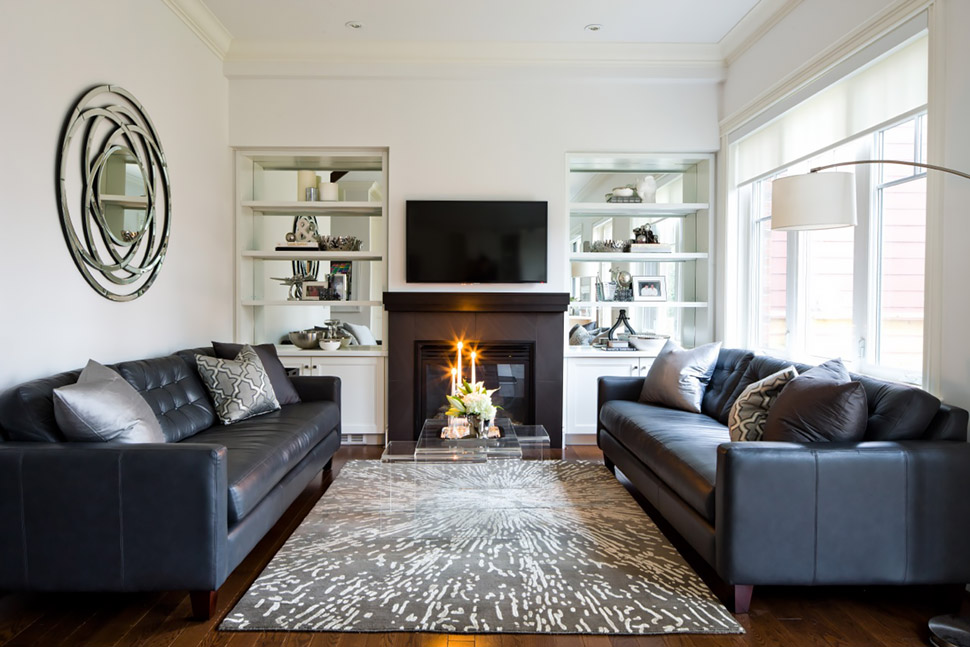
For anyone who knows me, you have met Baxter, my pride and joy. Baxter is my six-year-old beagle I got from the rescue Adopt-A-Dog/Save-A-Life, in Toronto. He has been a constant bright light! That being said, I’m also a homeowner and an interior designer, so Baxter has brought new dimensions to my life in numerous ways.
When Baxter arrived home, over five years ago, he had to contend with a new loving home filled with unfamiliar smells and routines as well as my old and very grumpy/mean cat, Matisse. It took about 48 hours for them to establish a hierarchy that basically put Matisse at the top, where he had always been. (And had no intention of letting go!)
This all frames the reference from which I now look at fabric in the design and decorating business. With Matisse and Baxter, both shedding fur and both having claws and neither wishing to obey any kind of rules about remaining off furniture, it has been my mission to figure out which fabrics perform the best on furniture. As an interior designer, this obviously matters to me professionally, but I certainly don’t want a home that looks shabby because the fabrics I select can’t stand up to the loves of my life.
Here are some tips to make the furniture and fabric in your home pet-friendly.
1. Texture and colour fabrics hide fur
Select a sofa and chair fabric with texture or pattern to hide lost fur. As crazy as it sounds, try to pick options that match the colour of your pet. I have tri-colour animals, (black, white and brown) so I really wasn’t going to win this. However, I have found that medium-toned grays and creams with flecks of charcoal, brown and black through them are the best for hiding fur. Tweeds and textured herringbones are good for this as well and look quite stylish today. I like Avant Garde, Nubia, colours 59 and 60 if you are looking for a good fabric to purchase or reference.
2. Natural fibers are harder to clean
Synthetic fabrics will be much easier to wipe clean should your favorite furry friend have an accident on the furniture. Today’s technology in fabric has made polyesters and nylons look and feel better than ever before. The benefit of these fibers is their non-absorbent qualities, so liquids will not penetrate, giving you time to clean them. Stains and smells can be easier to manage. Also wool, a fiber I generally like, can actually wrap lost fur into its own fiber making the removal of fur almost impossible so rethink this choice. Check out Sunbrella for fabrics that repel liquids.
3. Buy furniture with zippers
Good quality furniture will have zippers on every pillow including the large seat pillows so buy quality. This is a very important investment to make when you own a pet! This allows you to remove and clean individually soiled sections as required. Covers can even be taken to the dry cleaner for thorough cleaning if necessary.

4. Consider leather furniture
Although considerably more expensive, full-grain, high-quality leather can be a good solution where easy wiping is required. And leather will last a lifetime. I noticed my cat, Matisse, had little interest in being near my leather chairs so he avoided these completely. This is good news as he scratched everything else! If leather is against your principles you can look at excellent vinyl options as an alternative.
5. Microfiber holds up very well to pets
A cat that scratches furniture is very difficult to manage. Any fabric with threads will not withstand a cat’s claws. A high-quality microfiber like Robert Allen’s Sensuede II is amazing at minimizing the look of severe damage from a scratching cat. It does show punctures of the claw, but the fibers won’t pull so it’s not nearly as obvious as damage to a traditionally woven fabric! Sensuede also withstands any staining and is very durable in general. This is a high-grade microfiber so it’s not cheap, but well worth it for withstanding day-to-day high wear.
6. Make a matching fabric cover
For my house, and numerous pet-owning clients, we make a matching cover or blanket while we are building their new sofa. It’s made from the same fabric and it covers the seat or back of the sofa making it hard to tell that it is actually covered. This is a much better looking solution than old sheets applied to furniture to keep the pet’s fur and dirt off. Plus these blankets can be cleaned much more frequently than the furniture itself.
7. Add throw pillows to your favourite seat
I know this sounds like a sneaky designer trick to get more pillows into your home, but it is actually a pretty good method to cover your sofa or chair from damage. I have found my pets are uninterested in moving my pillows and walk across them, rather than sit on them. Every animal is different, but this is a good way to cover your favorite seating area on the sofa. Let’s face it, this is important to do when you have your black lululemon pants on and are lounging on the sofa. Covering your seating area stops the accumulation of fur from transferring to your butt! And no one likes a furry butt… even if it’s courtesy of your best friend!

